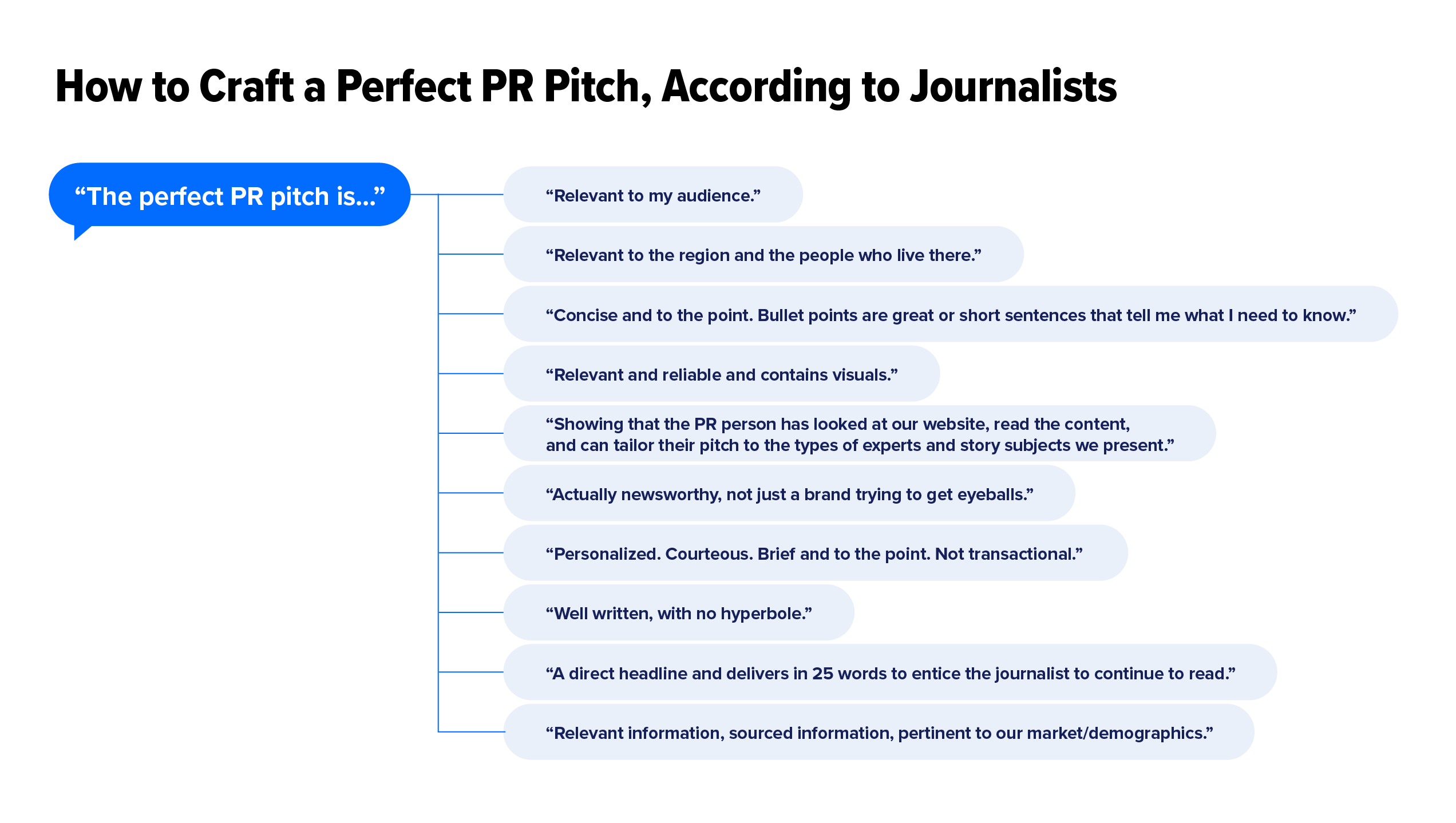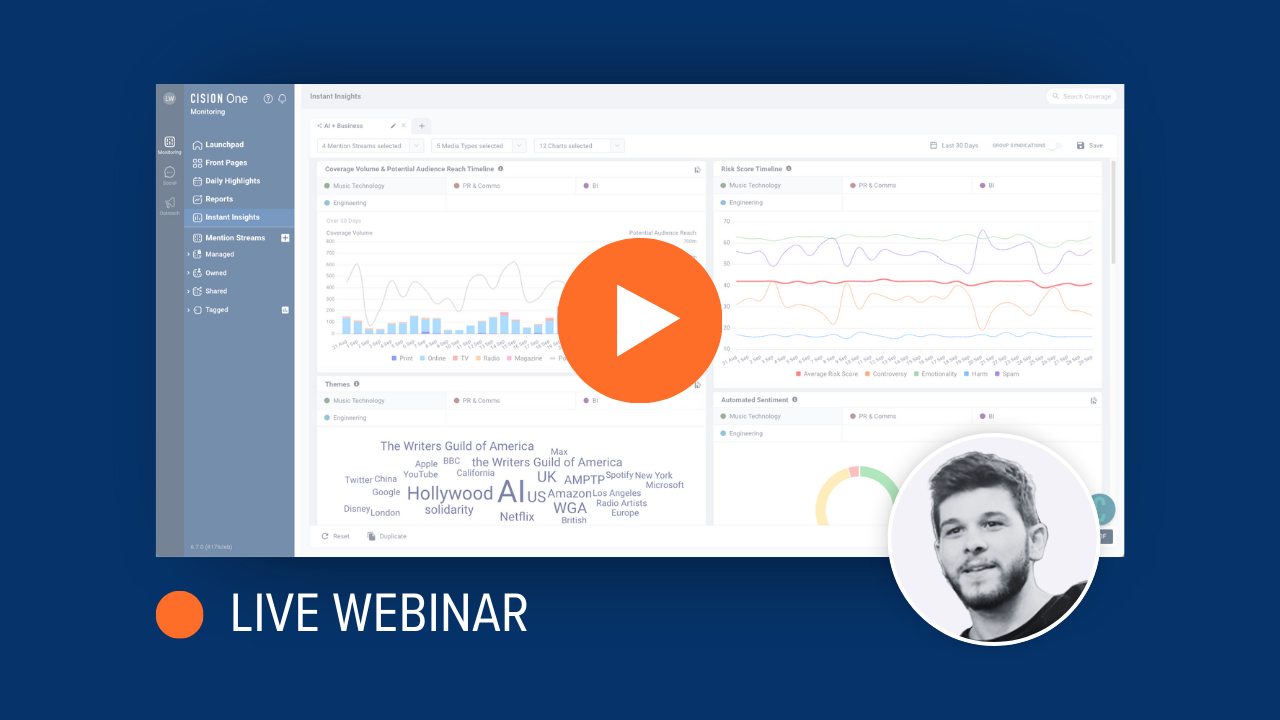As a public relations professional, nailing your pitches is everything. But are your pitches just blending into the endless stream hitting inboxes?
It might be time to rethink how you’re pitching, because a well-crafted pitch can open doors to valuable coverage, thought leadership opportunities, and heightened brand awareness. It’s the key to those meaningful relationships with the media professionals who shape our conversations.
While the goals of pitching haven’t changed, the media landscape has. These days, media outreach goes way beyond just traditional journalists. You’re also pitching to podcasters, broadcast personalities, celebrities, content creators, and more influencers across endless channels and platforms.
And just like there isn’t one type of media professional, there isn’t just one type of PR pitch or approach to pitching (far from it, in fact). Feeling overwhelmed? We’ve got you covered.
Consider this article your guide to understanding what those pitches are, when they’re right for you to use, and how to make each one stand out.
Using data from our 15th annual State of the Media Report, a survey of more than 3,000 media professionals, influencers, and bloggers, we’ve outlined the best practices for PR pitching, the most common pitch types, and how to capture journalists' attention (in a good way).
The Perfect PR Pitch Checklist: Universal Best Practices
We’ll get into the specifics of the different types of PR pitches and what makes them unique, but let’s start with the basic best practices – culled from years of surveying thousands of journalists. Whatever you might be pitching, these general rules will win you favor with the journalists you’re reaching out to, if not immediate coverage:
1. Relevant & Personalised
Sixty-eight percent of media pros say the number one way PR professionals can make their job easier (and increase the chances they’ll cover your story) is to understand their audience and what’s relevant. Their success is primarily measured by views and engagement, so they review pitches through this lens. If you’re not personalising your pitch to the journalists and their audiences, save yourself the effort because it most likely won’t get read.
2. Answers the Question: “Why Does It Matter?”
Your pitch must offer truly newsworthy information that’s timely, and genuinely matters beyond just your organisation. It should be something that holds value for, or has the potential to impact, the journalist’s audience.
3. Smart Subject Line
The subject line of your pitch is often the first chance to make an impression – make it count. Keep it short and punchy (under 60 characters, if possible). Start with “pitch” or “story idea” to set context. Then give a clear, direct topic description to whet their appetite. Steer clear of spam filters by avoiding all caps, exclamation points, and click-bait language. It’s okay to be clever, but salesy subject lines won’t do you any favours – over half of journalists will block PR pros who send pitches that sound like marketing brochures.
4. Clear & Concise
Respect their time – keep pitches clear and concise. The ideal length varies from 20 to 200 words, so cover the pertinent details of who, what, when, where, and why as briefly as possible. Include one link to assets like your press release, multimedia, research, spokesperson bio, etc.
5. Press Release Placement
Your pitch has a difficult job to do – selling journalists on why they should cover your story, while meeting journalists’ desire for pitches that are brief. The solution? Include a link to your accompanying press release. It has all the background on your news, so it’s a great way to keep your pitch concise and focused.
6. One Call-to-Action
End with a clear next step for the journalist - scheduling an interview, requesting more information, setting up a meeting, etc. Share your contact info and willingness to work with them in adjusting your story angle as needed.
7. Error-Free
Double-check details like the journalist's name, their contact information, and proofread everything. Silly mistakes can undermine your professionalism and hurt your chances of making an important connection. Eighty-seven percent of media professionals prefer email for pitches, so it’s best to go that route unless otherwise noted in their contact preferences.

7 Types of Media Pitches: When to Use Them and How to Make Them Stand Out
Now that we’ve covered the best practices for pitching in general, let's look at the various types of PR pitches to bring attention to your brand, client, or organisation, and the must-have elements to make each one stand out.
The Bylined Article/Guest Post Pitch
Industry experts with a unique perspective can stand out in journalists’ overflowing inboxes. Pitch an op-ed or bylined article featuring your expert’s fresh take on a hot topic. Be sure to express your willingness to develop the article according to the outlet’s style guidelines, and of course, tailor the content toward their audience.
Pro tip: If writing the piece in advance, check your target outlet’s website for style guidelines to ensure the article meets the outlet’s standards.
Must-Have Elements for Your Guest Post Pitch
Before sending your bylined article or guest post pitch, make sure you’ve covered the essentials:
- The author’s credentials and background
- A proposed title and brief summary/outline (link to article, or copy and paste the text below your pitch, if prewritten)
- A sentence or two explaining how the article aligns with the outlet’s audience
- The author’s availability for meetings/interviews
- Links to relevant, hi-res images, such as the author’s photo
The Community Engagement/Corporate Social Responsibility (CSR) Pitch
“Feel-good” stories almost always make for compelling content. This pitch is all about telling the public how your brand is truly making a positive impact on society - through community initiatives, charitable activities, sustainable practices, etc. For example, has your company committed to more sustainable business practices? Is your company donating some of its proceeds to a charity? Or maybe you’ve organised a companywide volunteer initiative. To make it newsworthy, explain how it’s creating meaningful change for the public, or tie these efforts to broader conversations taking place today.
Pro tip: For local or regional community initiatives, make sure you're only pitching journalists who cover the location. This is an important factor for making your pitch relevant and newsworthy.
Must-Have Elements for Your Community Engagement Story
Here are a few must-haves for your community engagement pitch:
- A description of the initiative description and the goals
- Your brand’s contribution details
- Community testimonials or participant anecdotes
- Links to visual content such as logos, photos, videos, or infographics
- Spokesperson interview availability
The Company News Pitch
Keep the media informed of your client’s or organisation’s big milestones - new leadership, awards/recognition, acquisitions, new partnerships, and more. Regardless of the announcement, be sure to highlight how your news impacts the audience. Perhaps, for example, this news marks an exciting change for the company that will lead to more innovative offerings for customers.
Must-Have Elements for Your Company News Pitch
Include these details in your company news pitch to improve your odds for coverage:
- A concise news summary
- Context on why it matters to the public
- Executive or stakeholder quotes
- Links to visual assets such as logos, photos, graphics, videos, or infographics
- Interview availability of applicable company representatives
The Event Promotion Pitch
Is your client or brand hosting an event? Sponsoring one? Is someone at your organisation speaking at a conference, festival, or community celebration – or making a special appearance at one? When it comes to events, there are many ways to get involved – and a good opportunity to get media attention for it. Not only can the media help create buzz to bring audiences to your event, but they can also make plans to attend and cover it themselves (though getting them free and easy access is key to making that happen). We also know from our data that access to events is one of the top things journalists want PR pros to provide.
Pro tip: If your event is in-person, make sure you're only pitching journalists who cover the location. This is a major pet peeve for the many media pros from local and regional outlets.
Must-Have Elements for Your Event Promotion Pitch
Don’t skip on the important details in your event pitch. Here are some must-haves:
- Date, time, location details
- Registration or ticketing info
- Schedule/agenda
- Notable speakers/attendees
- Photos, video, interview opportunities
- Free media passes
The New Product or Service Pitch
These pitches introduce your brand’s new or enhanced offerings, highlighting the key benefits and how it solves consumer pain points. When looking for this type of coverage, don’t forgo freelancer outreach: 42% of freelance journalists expressed explicit interest in products/samples to test, which is 20 percentage points higher than full-time staffers.
Must-Have Elements for Your Product or Service Pitch
To prevent your product or service pitch from being shelved, be sure to include:
- A brief overview of key features/benefits
- Unique selling points
- Any special promotions or discounts customers can take advantage of
- Target audience details (who will benefit from this product or service?)
- An offer for a free “test-drive” of the service or product
- Customer testimonials
- Links to visuals like images and video
The New Research/Breakthrough Study Pitch
Does your client or organisation have original research or new and interesting data to share? Great, because journalists want it - 61% say this is exactly the type of content they’d like to receive from PR teams. Not only does unique research make for interesting and impactful content, journalists are hyper-concerned with maintaining audience trust, and data adds valuable credibility to their coverage. Even just one stat can be all the foundation needed for timely and relevant content, if it’s connected to current trends or conversations.
Must-Have Elements for Your Research Pitch
Be sure to include the following in your research pitch:
- Key findings and methodology
- The implications of the research for the industry, market, or target audience
- Access to the full report or study
- Links to visuals such as data visualisations, charts, and graphs
- Interview availability with any relevant spokespeople
The Thought Leadership Pitch
Is your client an expert on a subject matter that’s in the news? Do they have a fresh or surprising perspective to share? Can they offer up a different side to the story, add another layer, or weigh in on the implications?
Thought leadership pitches can take many forms, but the goal is positioning your brand as an authority in the industry. Offering an expert’s fresh or surprising perspective on industry trends, news, or events can make for a headline-worthy story. And we know from our State of the Media report that not only do journalists explicitly want PR teams to connect them with industry experts, but they consider them a great source of content.
Must-Have Elements for Your Thought Leadership Pitch:
To make sure your thought leadership pitch has credibility and garners immediate interest, include the following elements:
- The expert’s unique perspective and story angle, tailored to the journalist’s audience (don’t bury the lede)
- The expert’s credentials and background
- Relevant quotes or soundbites from the expert
- Examples of previous commentary or media appearances
- The expert’s interview availability
Target the Right Media Pros
The #1 pitching rule? Only pitch what's relevant to each media professional's topics and audience. It's better to have a short, solid media list than risk turning people off with irrelevant stories. Do your research on the journalists, their platforms, and their audiences. The more you know, the better you can tailor your pitches - and the higher your chances of success.
Even More Media Relationship Advice
Effective pitching is about building rapport and value - not just pushing stories. Developing those long-lasting, mutually beneficial relationships takes effort, but it’s worth it. Take a deeper dive with these resources:
- State of the Media Report
- Mastering the Pitch: Data-Backed Strategies for Smarter PR
- Which Influencers Are the Most Effective? The Answer Varies
To find out how CisionOne can help with your media outreach, explore the platform or speak with one of our experts.
Most Recent Posts
Cision Resources
-
E-books and Guides
Comprehensive how-to guides on strategy and tactics
-
Case Studies
What are other brands doing – and how can we learn from them?
About Amy O'Connell
Amy O'Connell is the Global Content and Experience Producer at Cision. She is a skilled marketing and communications professional with over 15 years of experience across various industries.
Learn More. Do More. demo new
PR Tips, Case Studies, and Product Updates

[On-Demand Webinar] The Next Generation of Media Intelligence: From Gorkana to CisionOne
Explore CisionOne, a revolutionary media intelligence platform, and the evolution of Gorkana. Learn key features and strategies from Luke Williams, CisionOne Product Marketing Manager. Elevate your media outreach to new heights!


